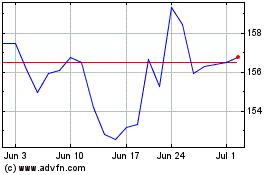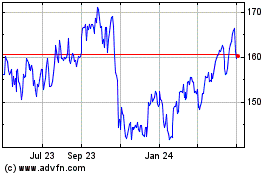By Bradley Olson
Chevron Corp. and Exxon Mobil Corp. plan to significantly ramp
up production in the oil field at the heart of the American
fracking boom, the latest sign that the next era of shale drilling
is likely to be led by the major oil companies.
In the next five years, Chevron expects to more than double its
production in the Permian Basin in Texas and New Mexico to 900,000
barrels of oil and gas a day, the company said at an investor event
Tuesday. That is a nearly 40% increase from its previous
forecast.
"The shale game has become a scale game," Chevron Chief
Executive Mike Wirth said in an interview. "The race doesn't go to
the one who gets out of the starting blocks the fastest. The race
goes to the one who steadily builds the strongest machine."
Not to be outdone, Exxon on Tuesday announced plans to increase
its Permian output to one million barrels of oil and gas a day by
as early as 2024, a day before it was expected to disclose growth
at its own investor meeting Wednesday. BP PLC, Royal Dutch Shell
PLC and Occidental Petroleum Corp. are also focusing on the
region.
"We're increasingly confident about our Permian growth strategy
due to our unique development plans," Neil Chapman, Exxon's senior
vice president, said in a written statement.
Big oil's growing ambitions for the Permian follow a
long-established pattern in the oil patch: Wildcatters and small
exploration companies find ways to tap new reservoirs, then the big
companies move in.
Five years ago, Exxon, Chevron, BP, Shell and Occidental
collectively made up about 9% of crude production from modern
fracking techniques in the Permian. In October, the latest period
for which relevant figures are available, they made up about 16%,
according to data on ShaleProfile, an industry analytics
platform.
Those numbers are likely to grow significantly in the coming
years, and it wouldn't be a surprise for the big five to produce
far more of the booming area's crude within a decade, said Ed Hirs,
who teaches energy economics at the University of Houston.
"It's going to be extremely difficult for smaller companies to
compete with the oil giants," Mr. Hirs said.
As the energy giants continue their shale expansion, many have
gained favor with investors. Chevron is up 14% in the past year
even as crude prices have fallen, and all the biggest oil companies
have outperformed the S&P 500.
Chevron, which now has the lowest debt relative to its size
compared with any of its peers, says it can pay for its new
spending and dividends at a price of about $51 a barrel. The
company said that is the lowest among the big oil companies, citing
data from analytics firm Wood Mackenzie.
Chevron plans to avoid major spending increases in coming years
even if prices rise, executives said. It said it would hold annual
spending this year and next year between $18 billion and $20
billion, and allow it to grow slightly from 2021 to 2023 to a range
of $19 billion to $22 billion.
Many of the smaller companies that pioneered new technology to
help make the U.S. the world's top crude producer have begun to
struggle as they attempt to rein in spending and move closer to a
goal that has so far largely eluded them: profitability.
Dozens of companies including Continental Resources Inc. and
Pioneer Natural Resources Co. have reduced spending plans in
response to investor pressure. Collectively, spending among the
smaller companies is set to fall 11% this year, according to
Citigroup.
Many smaller oil firms face the challenge of having to drill
more to keep production rising, because shale wells produce a lot
in the beginning but then taper off quickly.
The spending cuts, coupled with the fact that some companies
have tapped a large proportion of their best wells, mean that
returns from shale drilling might have already peaked as wells
increasingly are less productive, according to Evercore ISI.
Meanwhile, the big companies are just getting started. Exxon is
now the largest operator in the Permian, with almost 50 rigs. The
company estimates its Permian wells can generate a 10% rate of
return at an oil price of $35 a barrel. While many companies
reduced fracking activity in the fourth quarter of last year, Exxon
increased it significantly to over 80 wells, more than double the
total in the fourth quarter of 2017, according to Rystad
Energy.
Chevron is raising its production guidance to 900,000 barrels of
oil and gas a day by 2023. Last year, it predicted 650,000 barrels
a day by 2023. The company is boosting production without adding to
its rig count, a testament to how size can lead to greater
efficiencies.
Chevron employed what could be described as a tortoise-and-hare
strategy in the Permian. While smaller companies at times paid more
than $40,000 an acre to gain rights to prime drilling
opportunities, Chevron held on to land it already owned in the
region, which decades ago was one of the world's biggest
traditional oil fields, without having to join in the buying
frenzy.
The company's land is now recognized as having unrivaled value.
Its shale portfolio, which includes its Permian holdings, is worth
more than $70 billion, the largest of any operator, according to
Rystad Energy. Chevron says the value has doubled in the past two
years.
Chevron built a database of more than 25,000 wells to study the
best techniques for drilling. That helped it avoid so-called
downspacing, a practice in which companies drill wells in close
proximity and that has been linked to reductions in productivity
per well, Mr. Wirth said.
Because of its size, Chevron has the ability to obtain
commitments for pipeline space, drill longer horizontal wells
across its huge swaths of land in the Permian, and keep a lid on
labor and other materials costs. The company can also apply new
technology and use techniques mastered in the Permian on land in
Canada, Argentina and Pennsylvania, he said.
"At times, we were criticized for not going faster," Mr. Wirth
said. "We were steadily building up the knowledge to do this well,
not to do it fast."
Write to Bradley Olson at Bradley.Olson@wsj.com
(END) Dow Jones Newswires
March 05, 2019 14:22 ET (19:22 GMT)
Copyright (c) 2019 Dow Jones & Company, Inc.
Chevron (NYSE:CVX)
Historical Stock Chart
From Aug 2024 to Sep 2024

Chevron (NYSE:CVX)
Historical Stock Chart
From Sep 2023 to Sep 2024
